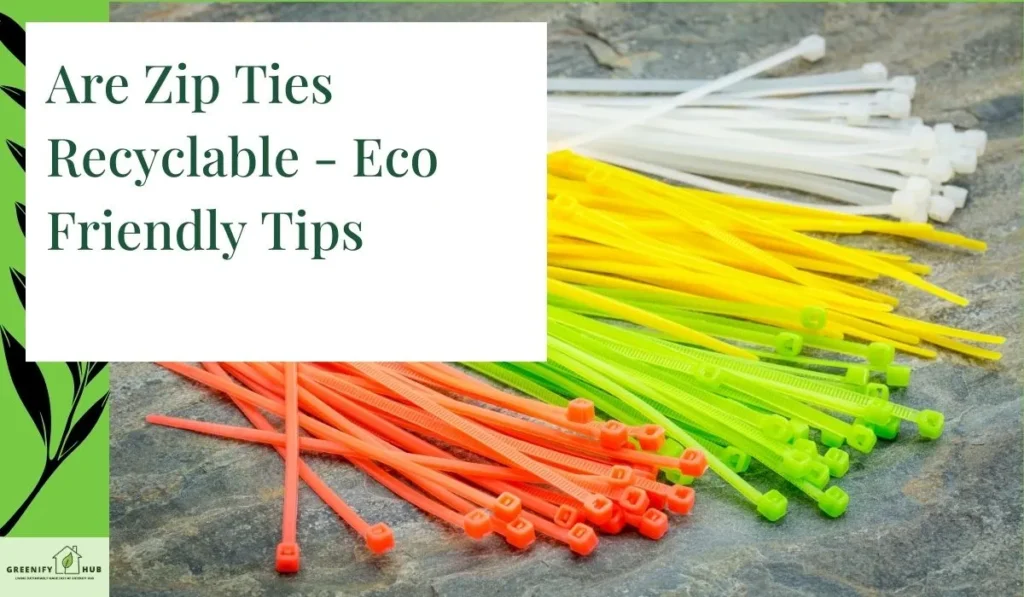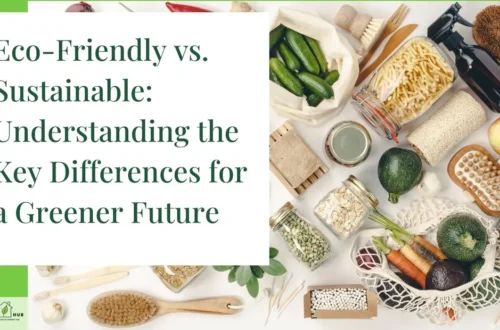Are Zip Ties Recyclable – Eco Friendly Tips

Did you know that over 100 million pounds of zip ties end up in landfills each year? Many people are unaware that these seemingly harmless household items can have a significant impact on the environment. The question of whether zip ties are recyclable is a pressing issue in today’s world of increasing environmental consciousness. Keep reading as we uncover the truth about the recyclability of zip ties and how you can make more eco-friendly choices in your daily life.
Key Takeaways
- Recycling Zip Ties: Zip ties are generally not recyclable through regular recycling programs due to their composition, but some specialized facilities may accept them.
- Limiting Use: To reduce environmental impact, limit the use of zip ties to essential needs and consider reusable options for temporary fastening.
- Exploring Alternatives: Explore eco-friendly alternatives like reusable silicone bands, Velcro straps, or biodegradable ties to minimize single-use plastic waste.
- Creative Reuse: Get creative with reusing zip ties for various purposes like organizing cables, securing plants, or crafting DIY projects to extend their lifespan.
- Choosing Recycled: Opt for recycled or upcycled zip ties made from post-consumer materials to support sustainable practices and reduce plastic waste.
- Awareness and Action: Educate others about the limitations of zip tie recycling and advocate for more environmentally friendly fastening solutions in your community.
Understanding Zip Ties
Definition
Zip ties, also known as cable ties, are fastening tools made of nylon or plastic. They consist of a flexible tape with teeth that can be threaded through a mechanism to form a loop.
Zip ties come in various lengths and strengths, suitable for different applications. The most common types include standard zip ties, releasable zip ties, and heavy-duty zip ties.
Types of Zip Ties
- Standard Zip Ties: These are the most commonly used zip ties and are ideal for securing cables, wires, and other lightweight items.
- Releasable Zip Ties: Unlike standard zip ties, these can be released and reused multiple times, making them more versatile.
- Heavy-Duty Zip Ties: Designed to withstand higher weights and tougher conditions, these are used in construction, automotive, and industrial settings.
Common Uses
- Construction Industry: Zip ties are used for securing scaffolding, organizing cables, and bundling materials on construction sites.
- Automotive Industry: Mechanics use zip ties to secure hoses, wires, and other components in vehicles.
- Home Improvement: In households, zip ties are handy for organizing cords, fixing broken items temporarily, and even creating DIY projects.
Are Zip Ties Recyclable
Nylon Zip Ties
Nylon zip ties, commonly used for various purposes due to their durability and strength, are not recyclable. The material composition of nylon makes it challenging to break down and recycle efficiently. As a result, once nylon zip ties have served their purpose, they often end up in landfills, contributing to environmental waste.
Recycling Programs
e manufacturers have taken steps to address the issue of zip tie waste by offering recycling programs. These programs allow consumers to return used zip ties to the manufacturer for proper disposal or recycling. By participating in these initiatives, individuals can contribute to reducing plastic waste and promoting sustainability.
Stainless Steel Zip Ties
In contrast to nylon zip ties, stainless steel zip ties stand out for their recyclability. Stainless steel is a highly durable and corrosion-resistant material that can be recycled multiple times without losing its properties. This makes stainless steel zip ties an environmentally friendly alternative to traditional nylon zip ties.
FAQs on Zip Ties
Reusability
Quality zip ties are designed for single-use only, making them difficult to reuse without compromising their integrity. Reusing zip ties can lead to reduced tensile strength and potential breakage.
Environmental Impact
Zip ties, if not disposed of properly, can contribute to environmental pollution. When left in nature, they can harm wildlife by entangling animals or contaminating ecosystems. Improper disposal of zip ties can have long-lasting effects on the environment.
Disposal Tips
- Cutting: When disposing of zip ties, cut them into small pieces to prevent them from causing harm if they end up in the environment.
- Recycling: While most curbside recycling programs do not accept zip ties, some facilities may recycle them. Check with your local recycling center for specific guidelines.
Limiting Zip Tie Use
Responsible Consumption
When it comes to limiting zip tie use, individuals can make a significant impact by being mindful of their consumption habits. Opt for reusable zip ties instead of single-use ones to reduce cable tie waste.
Consider the environmental implications of excessive zip tie usage. The current zip ties in circulation contribute to plastic pollution, harming ecosystems and wildlife. By tightening zip ties responsibly, we can minimize these negative effects.
Sustainable Practices
To reduce the environmental footprint of zip tie disposal, explore eco-friendly alternatives such as biodegradable cable ties. These options break down over time, lessening the long-term impact on the environment.
When purchasing zip ties, choose products from companies committed to sustainability. Look for brands that prioritize recyclable materials and ethical manufacturing practices. Supporting these businesses encourages responsible production within the cable tie industry.
Practical Alternatives
Instead of relying solely on zip ties, consider using other fastening solutions like Velcro straps or twist ties. These options offer flexibility and reusability, reducing the need for disposable zip ties.
For applications requiring a more secure fastening method, explore locking mechanisms that allow for repeated use without generating excess waste. Investing in high-quality cable ties with a durable release mechanism ensures longevity and reduces the frequency of replacements.
Benefits and Considerations
Pros:
- Minimize plastic waste.
- Support sustainable practices.
- Reduce environmental impact.
Cons:
- Initial cost may be higher for eco-friendly options
- Limited availability in some regions
Alternatives to Zip Ties
Biodegradable Options
Biodegradable cable ties are an excellent alternative to traditional nylon zip ties. Made from environmentally friendly materials, they decompose naturally over time, reducing plastic waste in landfills.
Benefits of biodegradable ties include their eco-friendliness and minimal impact on the environment. They provide a sustainable solution for fastening wires and cables without contributing to pollution.
Reusable Fasteners
Reusable cable ties offer a cost-effective and sustainable option for securing cables. Unlike single-use zip ties, these products can be used multiple times, reducing waste and promoting a greener approach to cable management.
Advantages of reusable ties include durability and versatility. They are ideal for various applications, such as organizing cords, securing items during transit, and managing cables in both residential and commercial settings.
Reusing Zip Ties Creatively
DIY Ideas
Repurpose plastic zip ties by transforming them into various useful items around your home. Create a colorful keychain by looping together different colored zip ties and attaching a key ring. These vibrant keychains not only look stylish but also help reduce waste.
Craft reusable cable tie plant markers for your garden by labeling each tie with the name of the plant. This simple yet effective method keeps your garden organized and adds a touch of creativity to your outdoor space.
Upcycled Decor
Transform old zip ties into unique pieces of art to decorate your home. Use colored zip ties to create a stunning wall hanging by weaving them together in intricate patterns. This eye-catching decor piece adds a pop of color to any room and showcases your artistic flair.
Craft a colorful vase by wrapping zip ties around a glass or plastic container. Experiment with different colors and patterns to match your home decor style. This upcycled vase not only looks beautiful but also promotes sustainability by reusing materials creatively.
Artistic Creations
Get inspired by artists who use zip ties as their primary medium for creating stunning artworks. Explore sculptures made entirely from recycled nylon cable ties, showcasing the versatility and durability of these materials in art. These intricate sculptures highlight the beauty of upcycled art and environmental consciousness.
Discover cable tie creations that range from intricate jewelry pieces to large-scale installations. Artists around the world have embraced zip ties as a unique medium for expressing their creativity and promoting sustainable practices. These innovative artworks serve as a reminder of the importance of reusing materials in art and everyday life.
Choosing Recycled Options
Environmental Benefits
Recycling zip ties is crucial for reducing waste and protecting the environment. By choosing recycled options, you contribute to sustainability and waste reduction.
Recycled zip ties are made from durable materials like stainless steel or other metals, ensuring they withstand various applications and environments. They are resistant to sunlight exposure and come in bulk, making them cost-effective.
Where to Find Recycled Zip Ties
When looking for recycled zip ties, consider reputable suppliers that offer a variety of options. These ties are available in different weights, such as lightweight polyester or heavy-duty metal.
- Look for recycled zip ties that are free from harmful chemicals and have a secure locking mechanism.
- Consider purchasing from manufacturers that prioritize sustainable practices and offer warranties on their products.
Benefits of Recycled Materials
- Choosing recycled zip ties not only benefits the environment but also ensures high quality and performance. They exhibit similar features to non-recycled ones but with the added advantage of being eco-friendly.
- Recycled zip ties can be used in various applications, from securing cables to organizing items at home or in offices.
- Their versatility and strength make them suitable for both indoor and outdoor use, providing a reliable solution for different needs.
Final Thoughts
Now that you know the ins and outs of zip ties, including their recyclability, it’s time to make a change. By limiting your use of zip ties, exploring alternative options, reusing them creatively, and opting for recycled choices, you can significantly reduce your environmental impact. Small changes in your daily choices can lead to a big difference in the world around you.
Take action by implementing these simple yet effective strategies. Together, we can work towards a more sustainable future where every choice we make contributes to a cleaner and healthier planet.





